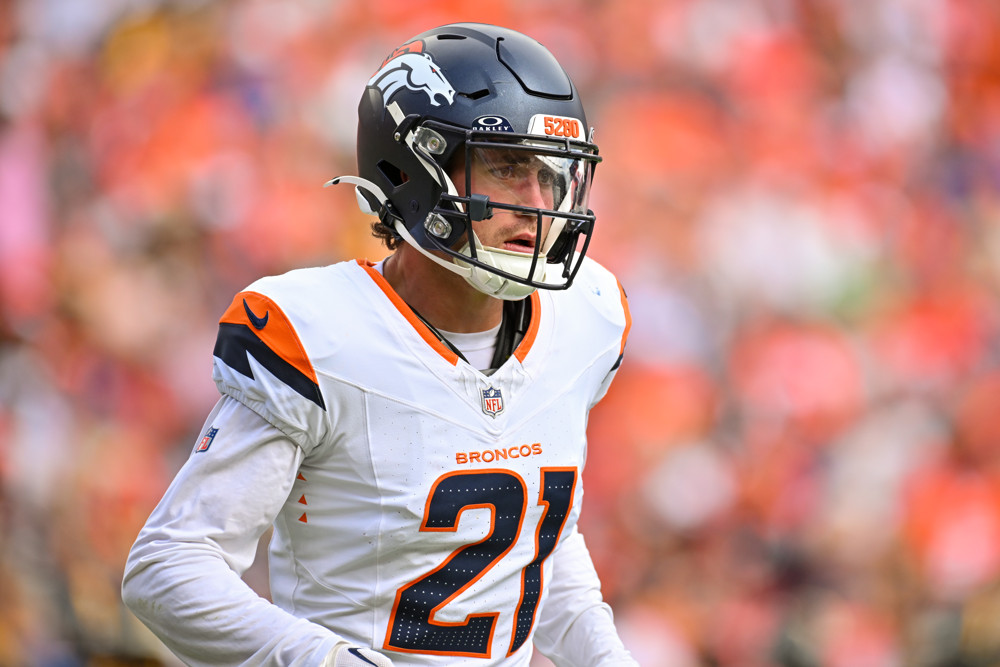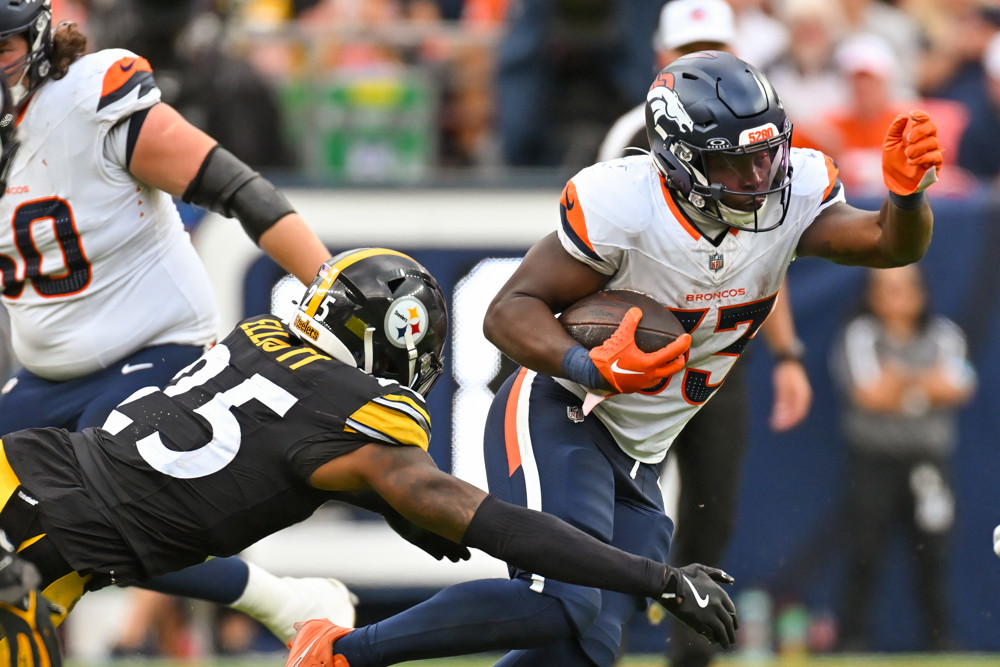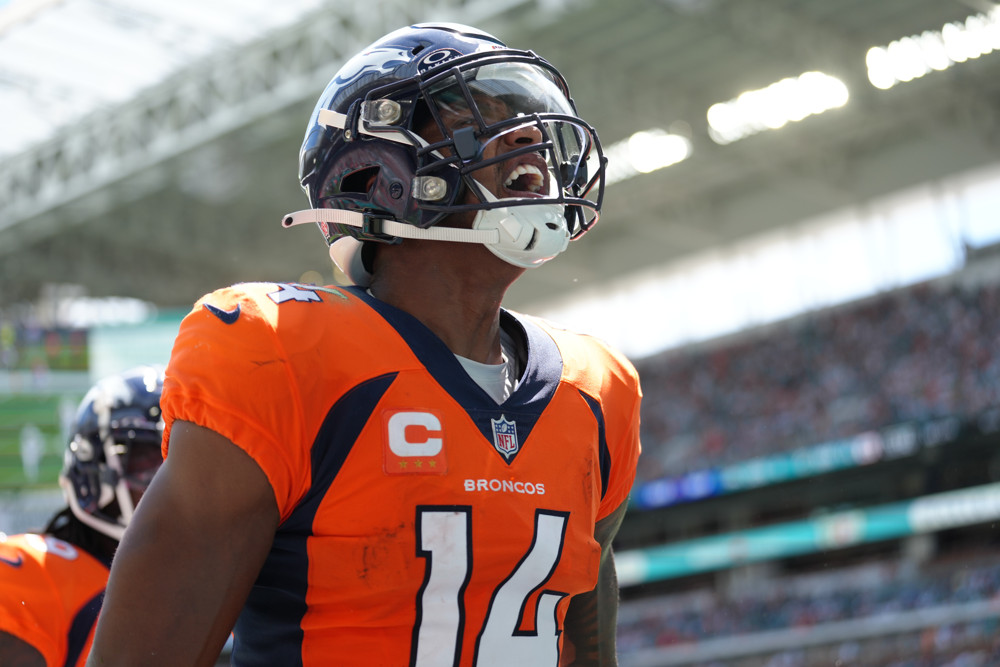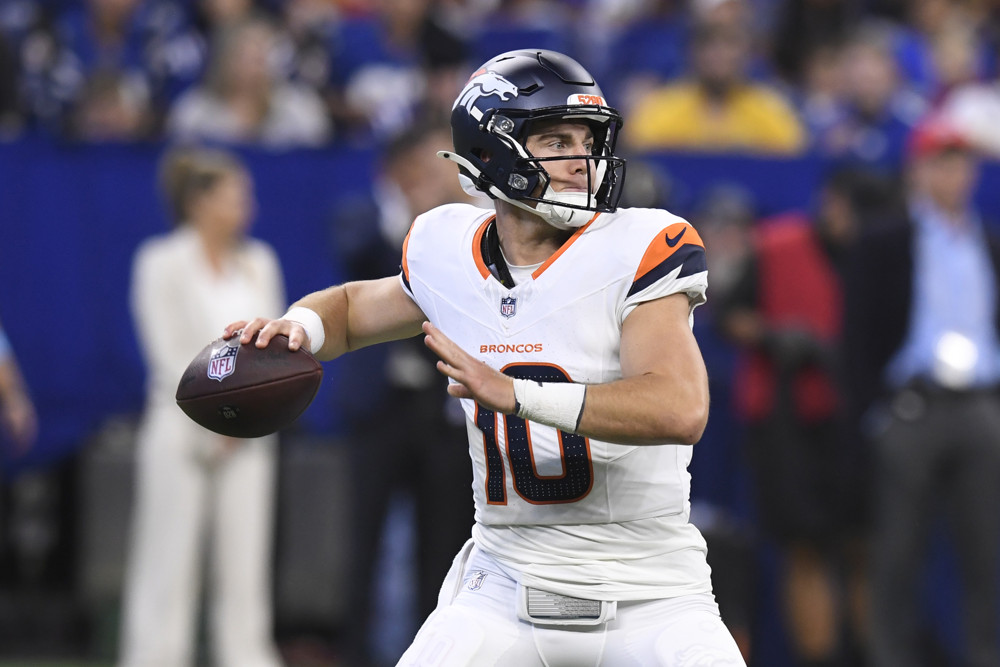
There’s something to be said for the proudest NFL organizations knowing how to win games, while others know how to lose them.
For too long the Denver Broncos have found themselves amongst the latter bunch, but, on Sunday, they ventured back into the light, and escaped with a victory they easily could’ve given away.
Who led the way for the Broncos in the nail-biting win, and who nearly sunk that delightful moment? Let’s look.
Previous Stock Reports
DENVER BRONCOS STOCK UP

Vance Joseph & the Denver Broncos Defense
Let this man cook.
Vance Joseph is a psycho for these calls late in the game vs Rodgers…
— Ben Fennell (@BenFennell_NFL) September 30, 2024
The Cover 0 pass off was awesome between Jones/McMillian! Then a funky zone pressure dropping out the mugging LB and DE – sending backside S free. pic.twitter.com/FRcvgMGFp9
If you had traveled back in time 12 months ago, and told a random Broncos fan that not only would there be a very real chance of Vance Joseph leaving the team for another head coaching opportunity, but that he also might be at the helm of the best Denver Broncos defense since the legendary 2015 squad, you probably would’ve been locked away in a rubber room.
Hell, people would have looked at you funny if you made that claim just two months ago, following the departure of longtime defensive stalwart Justin Simmons and the addition of a massive looming question at cornerback opposite Pat Surtain II.
Now, it’s impossible to deny that whether or not this is the best Denver Broncos defense since 2015 is a conversation worth having, and the competition for that honor is pretty fierce.
That said, the defense was pretty great through three weeks, so why is this week the difference-maker that inserts the 2024 group into that convo?
To date, Aaron Rodgers is arguably the best quarterback they’ve faced, the New York Jets’ offensive line is the best line they’ve seen, Garrett Wilson is the best receiver they’ve had to guard, and Breece Hall and Braelon Allen are, at worst, two of the three most dangerous backs Denver’s defended so far.
Nonetheless, Denver throttled the Nathaniel Hackett-led squad like an overeager pitbull puppy that just got handed a fresh chew toy.
Jets trailing 10-9 and Aaron Rodgers limping off gingerly after a sack/lost fumble. pic.twitter.com/nSfTySL4IN
— Glenn Naughton (@JNRadio_Glenn) September 29, 2024
Except, rather than stuffing and cloth being thrown through the air with reckless abandon, it was Aaron Rodgers’ limbs.
“Rodgers hit before he throws … SACK!”
— Denver Broncos (@Broncos) September 30, 2024
How @KOAColorado’s Dave Logan saw @PjLocke4’s fourth-down sack 🔊 pic.twitter.com/OFEauAileC
Through the first three weeks, the Jets’ rebuilt offensive line allowed 22 pressures, five quarterback hits, and five sacks. On Sunday, the Denver Broncos pressured Rodgers 14 times, delivering six quarterback hits, and five sacks.
"You gotta have some big cojones to call a zero blitz from the very first play of the game. Vance Joseph was dialing it up"
— DNVR Broncos (@DNVR_Broncos) October 1, 2024
— @BamBamDavis51 breaks down Justin Strnad's sack on the FIRST PLAY OF THE GAME👇 pic.twitter.com/guPU5Q1X5I
The coverage was equally exceptional. Aaron Rodgers completed just 57% of his passes at 5.4 yards per attempt, as Surtain held Garrett Wilson to two catches for 25 yards when in coverage on the star receiver.
What Pat Surtain II is doing to opposing WRs so far this season is incredible
— Field Yates (@FieldYates) September 30, 2024
Lockdown city (as usual) https://t.co/qVNXF9eTol
Finally, no performance was more notable than what Vance Joseph’s squad showed on the ground. Breece Hall, one of the league’s elite running backs, was held to four yards on 10 carries, and gained 75% of those yards on just one of his touches. Braelon Allen had more success, but still, a potent pair of backs were held to just 38 yards on 18 carries.
The Broncos held Breece Hall, one of the best running backs in the NFL, to 0.4 yards per carry.
— Zac Stevens (@ZacStevensDNVR) October 1, 2024
10 carries for 4 yards.
That performance answers some big questions about this defense’s greatest perceived weaknesses
On the season, the Broncos defense ranks fourth in EPA/play, fourth in defensive success rate, fourth in dropback EPA/play, ninth in dropback success rate, 8th in rushing EPA/play and 6th in rushing success rate.

In other words, whether the offense is looking for down-to-down consistency or explosive plays, the Broncos are shutting it down, and it doesn’t really matter whether the opposing offense is trying to attack through the air or on the ground.
So, how is Vance Joseph helping the Denver defense achieve these Herculean feats?
Vance Joseph surpassing Brian Flores as a blitz happy mad man
— Nick Kendell 🏔 (@NickKendellMHH) October 1, 2024
Denver now leads the NFL in Cover 0 calls and is 3rd in Cover 1
They are sending the house and trusting those DBs to not get beat and TACKLE to GREAT results so far https://t.co/6yeIZEsgqG
He is leaning hard on Pat Surtain II and the rest of the Broncos’ remarkable secondary to lockdown the opponents’ weapons, oftentimes one-on-one, so that he can dial up absurd pressures on half of the opposing quarterbacks’ dropbacks. He is also drawing up some downright dastardly looks, bringing the house on a fourth-and-inches one week, and dropping nine in coverage another week.
🔊 Going over the different 3rd down looks Vance Joseph threw at the Steelers offense this past Sunday. It was really fun to watch the Broncos DL go against the Steelers OL. Heavyweight matchup. pic.twitter.com/Ugej3IlbtF
— Robby (@Robby_NFL) September 19, 2024
Elevating that game plan to the remarkable peaks Denver is achieving is a product of the players though.
Brandon Jones has made fans quickly forget about Justin Simmons, while P.J. Locke is a pretty obvious upgrade on late-stage Kareem Jackson.
We stan Vance Josephpic.twitter.com/M7wykLP6Dl
— Romi Bean (@Romi_Bean) September 29, 2024
Pat Surtain II is penning a masterwork underappreciated because the scale of difficulty guarantees mistakes, and cornerbacks are defined by their down reps, but it has the potential to be the best year of his career if he can keep it up.
Patrick Surtain II weekly victims list:
— Zack Kelberman (@KelbermanNFL) October 1, 2024
🔒 DK Metcalf: 29 yards allowed
🔒 George Pickens: 16 yards allowed
🔒 Mike Evans: 8 yards allowed
🔒 Garrett Wilson: 22 yards allowed pic.twitter.com/TZD9EboLmu
Meanwhile, Ja’Quan McMillian has taken a step forward from last season, which is promising considering his declining play down the stretch of 2023, and Riley Moss continues to be the most pleasant surprise across the entire roster.
The Broncos' Riley Moss takes a hard stab with his inside hand and then swipes his wrist until he gets in phase.
— Cody Alexander (@The_Coach_A) October 1, 2024
Eyes down on the hip & only turns when he is in a position of control.
— pic.twitter.com/hO9J0boaDw
The defensive front is a raging storm of physicality, speed, and bend, absolutely brutalizing offenses when paired with Joseph’s designs. Zach Allen, who would be getting Defensive Player of the Year buzz if he had more name recognition and/or was on a contending team, is, of course, also a key element to the pass rush’s detonation of opposing offenses.
.@Broncos @TheZALLEN44 continues to be one of the consistently more dominant defensive lineman in the NFL. Great technique; combined with MAXX effort is a great combo #BaldysBreakdowns pic.twitter.com/bEcHAn5HV8
— Brian Baldinger (@BaldyNFL) September 30, 2024
Adding to the amount of acclaim Vance Joseph is due is the fact that offense is down leaguewide, and Joseph’s squad still ranks ahead of his contemporaries in so many categories. More importantly though, the offensive drought the league is presently experiencing deflates the importance of the passing game, to some extent, and increases the value of the rushing attack.
This Denver Broncos team is positioned to thrive in a realm that emphasizes defense and running, and Vance Joseph is arguably the No. 1 reason as to why.
Javonte Williams and Jaleel McLaughlin

Just one week after everyone decided to trade in their Javonte Williams and Jaleel McLaughlin stock for a Tyler Badie investment, Williams and McLaughlin looked rejuvenated.
Williams and McLaughlin toted the rock a combined 23 times for 123 yards, finishing the game just short of the 5.0 yards per carry mark.
Look at the seal from Palcewski, Quinn working to the second level, and the finish from Javonte Williams.
— Frankie Abbott (@FrankiesFilm) September 30, 2024
Denver should feel no need to rush McGlinchey back from injury. pic.twitter.com/bw39nmIrR6
With 73 yards by himself, Williams more than doubled his rushing total from the first three weeks on eight fewer carries. He also notched his first explosive run of the season, with a 16-yard thundering carry.
Most importantly though, his physicality and power looked more like the pre-injury version of Williams, with five missed tackles forced, equaling his total from Weeks 1 through 3. That rate of .313 missed tackles forced per carry compares very favorably to Jordan Mason, who currently leads the league with 21 missed tackles forced, and his rate of .231. 10 missed tackles forced on the year is also enough to tie Williams for 14th-most in the league.
Javonte Williams getting back to his old self?
— Jordan Lopez (@JordanTLopez) September 30, 2024
Ranks in the top ten in Week 4 for Yards after Contact (58 yards) and Rushes of 10+ yards (3)
Would be huge going forward for Nix and the offense pic.twitter.com/QWkABAdl1n
McLaughlin also eclipsed his season-long rushing total with the 46 yards he accumulated on Sunday. His rushing ability didn’t seem much different, though he did appear a little harder to bring down, but, unlike previous weeks, he had room to work with and didn’t have all of his touches sniffed out by the defense.
The line had its second-straight week of much-improved play, this time coming against a better defensive opponent, which was another major reason for both backs’ big games.
Plus, Broncos Country should have some optimism about this rushing growth to carry into Week 5. New York ranks 21st in defensive rushing EPA/play and 27th in defensive rushing success rate, while the Las Vegas Raiders rank 24th and 18th, respectively.
Justin Strnad

Anyone who claims to have foreseen this lights-out showing from Justin Strnad against the New York Jets should not be trusted.
After being relegated to the role of core special-teamer the past few seasons, and signing a one-year deal worth just $400K more than the veteran minimum, the thought of Strnad ever thriving on defense became a relic of the past. That is no longer the case with his Week 4 showing now in the rearview.
The guys could do a whole Full Field Read show on just Justin Strnad's plays from today. pic.twitter.com/Z2qJcq8QNl
— LTB (Muse) (@LTB_Muse) September 29, 2024
Literally from the game’s first snap, Strnad played like a man possessed, flying through an open lane to violently bury Rodgers into the turf, and setting the tone for the rest of the game in the process.
Strnad finished the day with four tackles, two tackles for loss, and the aforementioned sack of Rodgers. He also proved to be sticky in coverage — which was much less surprising than his work around the line of scrimmage — as he was targeted just twice, allowing one reception for nine yards.
If Strnad can play like this the rest of the season, it would practically force the Denver Broncos’ hand to re-invest in him as a potential starter. Considering Alex Singleton’s unfortunately serious injury, and the fact the Broncos could save nearly $6 million by moving on this spring, Strnad has a golden opportunity in front of him.
Courtland Sutton

Courtland Sutton was a borderline missing person, with just 64 yards through the first two weeks of the season, but he’s made his presence felt these past two weeks.
Week 4 was his standout performance though, considering the passing attack fell apart in the adverse weather.
60 receiving yards and a touchdown is a strong, but ultimately irremarkable day. That is, until you realize the team only had 60 passing yards on the day.
Sutton immediately handing Bo Nix the football 🥹pic.twitter.com/CK0T0wIt3L
— Bryce 🎸 (@MileHighMims) September 30, 2024
Odds are Sutton will be the only receiver this season and over the next several seasons to be responsible for 100% of his team’s passing yardage. On top of that, Sutton accomplished the feat with a series of impressive catches.
No one’s jaws were left on the floor, but it was still a welcome arrival for the Broncos’ best pass-catcher.
The Denver Broncos’ Organizational Stability
Through two weeks, things looked pretty grim for the Denver Broncos, even despite the defensive dominance. But, as the old saying goes, ‘winning cures all’ and now, the Broncos find themselves at .500 and are presently favored to improve to 3-2, which would put them halfway to overachieving relative to their preseason projected win-loss total, just one week into October.
The franchise is winning games, like the 10-9 nail-biter against the Jets, which it has usually lost during this post-Manning era, and they’re doing it without substantially better quarterback play.
Sean Payton was brought in, in part, to fix the offense and to solve the quarterback conundrum, and the jury is still out on those fronts — no debate there.
That said, Payton was also brought in to be the adult in the room for an organization that was desperate for one. He was tasked with coming in and mopping up the clown makeup the franchise coated itself in by hiring Nathaniel Hackett and trading for Russell Wilson, and in that department, he’s been successful.
Sean Payton’s culture is electric 🔥 pic.twitter.com/Zjljo6kIMm
— Denver Broncos 365 (@DailyBroncos) September 30, 2024
A few short months after the Dolphins dropped a 70-point bomb on the Denver Broncos, they had their best shot at the playoffs since Peyton Manning was hoisting a Lombardi trophy. One year after that detonation, the defense looks like it might be one of the best units in the league.
If the offense can follow suit, and improve from dismal to just mediocre — which doesn’t seem too far-fetched — the Broncos could be a frisky team during a year when they have absolutely no right to be.
This roster is still in its Chernobyl era following the franchise’s recent team-building failures, with few key contributors on rookie deals and $55 million in dead cap weighing the overall talent level down.
They were projected to win 5.5 games for good reason. Yet, one week from today, they could very realistically be one game back from the reigning two-time Super Bowl Champions.
When you hear the local gripes about Denver’s shortcomings all being Sean Payton’s fault, you would be wise to remember the present state of the franchise compared to the Hackett-led mess the current head coach inherited, and that Payton’s arrival in Denver dramatically limited the amount of access that local media had inside Dove Valley — a hurdle for media that would probably be removed once Payton is…
Sean Payton has
— Michael 🇲🇽 (@RespectMyCos) September 30, 2024
– Improved our training staff
– Hired VJ to fix our defense
– Hired Strief to improve our OL
– Hired Kotwica and Westhoff and FIXED our STs
– Has us set up with 72m in 2025
Now the offense is still a work in progress and I have faith in him to fix that! pic.twitter.com/6bPxdCBLnb
Just last year, one year after Russell Wilson was a bottom-three quarterback by almost any metric imaginable, and one year before Mike Tomlin sneakily benched him for Justin Fields, it was Payton’s fault that Wilson was only the league’s 20th-best quarterback and only producing elite numbers in the redzone.
Now, with the power of hindsight, that seems more miracle than sabotage.
DENVER BRONCOS STOCK DOWN

Sean Payton
Yes, a lot of the heat he’s currently facing is overblown, and Broncos Country should feel generally optimistic about the direction of this operation and considerably better than they did two weeks ago.
However, that still doesn’t excuse Payton’s baffling head coaching decisions from the 10-9 victory, or the fact that this is the third time in four games that the offense has set some sort of record for ineptitude.
Bo Nix did not complete a single pass beyond the line of scrimmage in the first half (0 for 8) while completing all 7 of his attempts behind the LOS for -7 yards.
— Connor Long (@NYFlightJets) September 30, 2024
Nix did not generate a successful play on any of his 16 dropbacks in the first half, becoming the first quarterback… pic.twitter.com/ivH1vSDHCQ
On the offensive ineptitude point, the rain is a fair excuse to an extent, but still, considering all the Denver Broncos have given up for Coach Payton, one would certainly hope he could provide a higher offensive floor. Plus, the fact weather wasn’t a factor the first two times we saw the offense look this way limits the effectiveness of that excuse.
The rookie quarterback is obviously a contributing factor, but it was Payton who went all-in on Nix and the draft and Payton who decided to start him Week 1.
Barring another cataclysmic hurricane, Denver’s offense can’t afford any more embarrassments at Sunday’s scale.
On top of all that, Payton almost cost the team the game with his game-management choices.
The first challenge decision was questionable, at best, and, as a result, the Denver Broncos weren’t able to challenge a clear takeaway that was blown dead, when that opportunity came up later in the game. Yes, the officials bungled that situation, but that’s why the coach’s challenge exists — so that you can hold the officials accountable when they do screw something up.
The decision to kick the field goal was also questionable. Metlife is one of the toughest stadiums in the league to kick in, the conditions were horrid, and Lutz was 8-for-14 on 50+ kicks since the 2020 season. That alone should be enough to bring a field goal into question, but when paired with the defense’s stunning performance and New York’s fledgling offense, it was incredibly foolish to risk a near 50% chance that you would give Rodgers and the Jets’ offense a ridiculously short field.
Thankfully, Greg Zuerlein missed the would-be game-winning kick, but that doesn’t change the fact that Payton’s decisions nearly cost Denver the game.
Bo Nix

It is admittedly frustrating that this disclaimer seems necessary before any sort of Bo Nix discussion, but so be it.
To be clear, we’re all on the same page that this is a rookie quarterback, in his fourth career regular-season start, playing a top-notch secondary, with sketchy offensive talent, in a driving rainstorm brought on by a natural disaster. Those are all understandable reasons for a quarterback to play bad, but, those reasons don’t erase the poor play from existence. It is best to acknowledge the entire context — both the poor play and the surrounding circumstances — as we try and discover what Bo Nix might be.
Alright, now that we’ve pacified the more sensitive fans, let’s get into it.
Bo Nix’s 1st half vs. 2nd half was dramatic in the broadcast and on paper
— Zach Segars (@Zach_Segars) September 30, 2024
1st half: -1.032 EPA/dropback, 0.0% success rate (YUCK)
2nd half: 0.246 EPA/dropback, 35.7% success rate
If he played like that all game, he’d rank 7th in EPA/dropback and 21st in success rate this week
Nix had the worst first-half passing performance of the 21st century in terms of yards, yards per attempt, and yards per completion. He boasted a success rate of 0.0% on his dropbacks in that first half, and his EPA/dropback of -1.032 suggests that calling a pass play for Nix in the first half was about as damaging as just giving the Jets a free point. He was 0-for-8 on throws past the line of scrimmage.
It was the type of bad we rarely, if ever, see from an NFL quarterback, frankly.
It also doesn’t take a rocket scientist to figure out why it happened.
Nix couldn’t grip the ball, and, as mentioned before, New York’s defense played at a very high level.
Now, we have only seen Nix play an NFL game in the rain once, so we don’t know whether these problems will be a constant with bad weather or if that weather was just so exceptionally extreme that it led to the struggles.
On the side of the ‘it was the weather’ argument is the fact Nix was much-improved in the less rainy second half, leaping from -1.032 EPA/play and a 0.0% success rate, which both ranked 32nd in the league this week, to an EPA/play of .246 (ranking seventh) and a success rate of 35.7%, ranking 22nd. Also, there’s the fact that Rodgers also had a terrible first half (-.149 EPA/play, ranking 23rd; 26.1% success rate, ranking 30th), before experiencing a similar leap in the second half.
My final comment on the weather for the Broncos Jets game.
— Erick Trickel (@ErickTrickel) October 1, 2024
When watching the game yesterday, I counted about five passing attempts clearly impacted by the rain for Rodgers compared to about 10 for Nix.
Rodgers 42 attempts while Nix had 25.
On the side of the ‘it was Nix’ argument is the fact that, although Rodgers struggled similarly in the first half, it was also very clear that he had markedly more control of the football than Nix did. Nix was shot-putting his passes throughout the half, which, again, was an entirely different degree of struggle than what Rodgers was experiencing.
Odds are, the truth is likely somewhere in the middle, and, until we see Nix play in another rain game, Broncos Country should have some trepidation about the rookie’s ability to handle the elements.
The first-half showing was also so disappointing because it raised some questions about what we saw against Tampa Bay. In Week 3, it felt like things were finally slowing down for Nix, but it would be hard to walk away from Week 4 with that same belief.
All that said, the start wasn’t entirely bad for Nix. Notching his first passing touchdown was a great achievement, as was his ability to drive the offense into scoring position twice with the game on the line. He also had one of, if not his best throw of the season, when he hit Sutton on a key dig route late.
Wil Lutz
Broncos Country hasn’t caught on yet, but Wil Lutz is not a good kicker, and the franchise will soon likely be faced with the same problem they had with Brandon McManus — a below-average, yet serviceable, kicker with inflated value.
This is a less expensive mistake to make at kicker than most other positions, but it’s a mistake nonetheless.
The baseline standard for kickers now is to be nearly perfect inside 50 yards, and reliable up until about 60 yards out. Lutz checks the first box but is far from checking the second.
Since 2020, on kicks from at least 50 yards out, Lutz is making just 53.3% of his attempts. The league average in 2023 was 68.7%. Plus, don’t forget, since 2020 Lutz has only kicked for teams that either play their home games in a dome or play their games a mile above sea level, so he’s had it easier than most kickers in the league, and is still underperforming to this extent.
